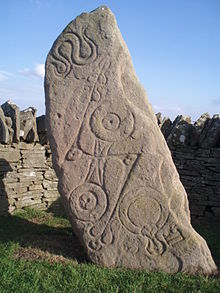
Back Pikte Afrikaans بيكتيون Arabic Pictos AST Piktlər Azerbaijani Пікты Byelorussian Пикти Bulgarian Pikted Breton Pictes Catalan Пикташ CE Piktové Czech

The Picts were a group of peoples in what is now Scotland north of the Firth of Forth, in the Early Middle Ages.[1] Where they lived and details of their culture can be gleaned from early medieval texts and Pictish stones. The name Picti appears in written records as an exonym from the late third century AD. They are assumed to have been descendants of the Caledonii and other northern Iron Age tribes. Their territory is referred to as "Pictland" by modern historians. Initially made up of several chiefdoms, it came to be dominated by the Pictish kingdom of Fortriu from the seventh century. During this Verturian hegemony, Picti was adopted as an endonym. This lasted around 160 years until the Pictish kingdom merged with that of Dál Riata to form the Kingdom of Alba, ruled by the House of Alpin. The concept of "Pictish kingship" continued for a few decades until it was abandoned during the reign of Caustantín mac Áeda.[2]
Pictish society was typical of many early medieval societies in northern Europe and had parallels with neighbouring groups. Archaeology gives some impression of their culture. Medieval sources report the existence of a Pictish language, and evidence shows that it was an Insular Celtic language related to the Brittonic spoken by the Celtic Britons to the south. Pictish was gradually displaced by Middle Gaelic as part of the wider Gaelicisation from the late ninth century. Much of their history is known from outside sources, including Bede, hagiographies of saints such as that of Columba by Adomnán, and the Irish annals.
- ^ Woolf 2017
- ^ Fraser 2009, pp. 43–67; Fraser 2011, pp. 155–44; Woolf 2017